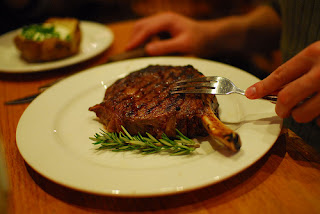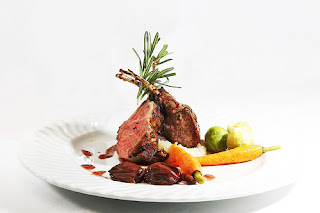The Argan Nut
www.flickr.com/photos/thedadys/16943563106/
The
origins of argan oil.
Argan
oil with its darkish color comes from the lightly roasted nuts of the argan
tree in the south-west of Morocco. The argan tree once covered large parts of
North Africa but is now a protected tree limited to parts of Morocco. With its
unique taste, the Berbers of Morocco have used it for centuries to flavor local
dishes. The nuts of the argan tree that supply the oil are very hard, and they
have defeated automated nut-cracking machines;
today, the oil is produced by co-operatives of Berber women.
French
chefs are always on the lookout for new tastes and the use of the tasty, though expensive, argan oil can renew interest in a chef’s favorite recipe. For new
dishes, the addition of argan oil will draw attention as it is an oil rarely found in private homes. France has had a long association with Morocco, the source of 99% of the world's argan oil, and Argan oil is not a new discovery. However, despite that interlocked history mainline French chefs only began to showcase the oil less than eight or ten years ago.
Organic argan oil
From the menu listings below
you may see that argan oil is used as a flavoring just like a fine virgin olive oil. That means it is added to an already cooked or cold dish; it is not
used for cooking as that destroys the flavor. When cooking with argan oil, the
flavor is king.
Your
menu with argan oil may offer:
Carpaccio de Dorade, Vinaigrette Tranchée à l'Huile d'Argan -
A Carpaccio of gilt-head sea bream, the fish, served with a vinaigrette sauce, distinctly
flavored by argan oil. (Tranchée
–In a restaurant, tranchée may mean sliced, but mostly will indicate something
that makes a clear-cut difference to the taste, or sharply contrasts with other
parts of a dish).
Poêlée de Champignons des Bois Assaisonnés à
l'Huile d'Argan - Forest mushrooms, wild
mushrooms, lightly fried and seasoned, and just before serving, flavored with argan oil. The climate limits
wild mushrooms to specific areas; ask for information on the mushrooms
served. Every restaurant has agreements
with its own ramasseurs, gatherers of wild mushrooms, and wild herbs. If you are lucky, you may be in France during
the Chanterelle Girolle mushroom season.
Légumes Acidulés, et Vinaigrette
à la Clémentine et Huile d’Argan
King
Scallop meat Carpaccio
with tangy vegetables and clementine and argan oil vinaigrette.
Suprême de Volaille au Citron Confit, Couscous
d'Aubergines et Fruits Secs Parfumé à l’Huile d’Argan - Chicken breast served with a lemon confit, along with couscous made from aubergines (the US eggplant), and dried-fruit lightly-flavored with argan oil. Here the breast of chicken is served with a lemon confit on the side. A fruit confit, as it is offered here, will probably have been the cooked until it reaches the consistency of a thick jam; it may have been sweetened or cooked without any additions. The lemon confit will provide a distinct contrast to the chicken breast as you can add the confit to suit your taste. The aubergine couscous and dried fruits, flavored with argan oil, make this dish a contrast in many flavors and textures. A dish like this is a real test of a chef’s ability to manipulate each component and allow the diner to enjoy the contrasts.
Miner's lettuce or winter
purslane, is a flowering plant that got its name during the California gold
rush.
www.flickr.com/photos/ideasinfood/8311235465/
Tartine de Truffesd'Automne à l'Huile d'Argan – Autumn truffles prepared with Argan oil and
served, probably, on toasted bread; possibly a sliced toasted baguette; a
tartine is an open sandwich. The Truffe
d’Automne, the Autumn truffle, is more commonly called the Burgundy Truffle,(the tuber uncinatum); this truffle has many names as it found in many parts of
Northern France and each area adopt this valuable truffle as their own. The
local gourmands, where this truffle is found, will insist it is superior to its
more famous and more expensive Périgord truffle cousin, the tuber melanosporum.
The tartine on which this truffle is served will be much like an open sandwich. This menu listing may be a French take on the Italian bruschetta. However, in a French home at breakfast, a tartine or tartine beurré means bread and butter.
The tartine on which this truffle is served will be much like an open sandwich. This menu listing may be a French take on the Italian bruschetta. However, in a French home at breakfast, a tartine or tartine beurré means bread and butter.
Goats in an Argan tree.
Visitors, in Morocco,
are often greeted by the sight of goats who climb the argan trees for their leaves.
www.flickr.com/photos/mikelsantamaria/16536682646/
Homard
Breton Grillé de Nos Côtes, Sucrine à l'Huile d'Argan - Grilled local Brittany lobster served with a baby Romaine lettuce
flavored with the argan oil. The sucrine is the lettuce sold under the name
Little Gem in North America. The oil used to baste the lobster while
grilling will not have been argan oil; there its taste would have been wasted;
the oil will be added to the lettuce only, and then just before serving. When
ordering lobster in France, be aware of their sizes and costs. The European
lobster is a very close cousin of the American lobster, but very much more
expensive in France than in North America; check the price
carefully. In France, the rock lobster, the owner of the lobster tail, is
a more economical, if slightly less tasty, alternative. The North American
lobster is imported into France as the Canadian lobster, the Homard Canadien,
and when on the menu, it will cost far less than its local relatives.
Discussions over which of these two-clawed lobster cousins are the tastiest are
without end.
Berber women in a cooperative breaking open argan nuts.
www.flickr.com/photos/yak4yak/6230412946/
Argan oil and cosmetics.
Argan
oil is rich in vitamin C, and its use in cosmetics where natural oils are
required competes with its use in the kitchen.
Since the oil’s supply is limited, its price is high,
Organic argan conditioner
www.flickr.com/photos/185690060@N08/49108026403/
--------------------------------
Behind the French Menu
by
Bryan G. Newman
behindthefrenchmenu@gmail.com
Copyright 2010, 2014, 2019, 2020
--------------------------------
Searching for the meaning of words, names or phrases
on
French menus?
Just add
the word, words, or phrase that you are searching for to the words "Behind
the French Menu" (best when including the inverted commas), and search with
Google, Bing, or another browser. Behind the French Menu’s links,
include hundreds of words, names, and phrases that are seen on French menus.
There are over 450 articles that include over 4,000 French dishes with English
translations and explanations.
Connected Posts:
















